While 3D printing gives you the ability to fabricate completely custom parts, it does have some drawbacks. One issue is the time and cost of printing large volumes. Often these structures are simple, and do not require completely custom design.
This is where the faBrickation system comes in. It allows you to combine 3D printed parts with off the shelf LEGO bricks. The CAD tool that lets you ‘Legofy’ a design. It creates directions on how to assemble the LEGO parts, and exports STL files for the parts to be 3D printed. These custom bricks snap into the LEGO structure.
In their demo, a head mounted display is built in 67 minutes. The same design would have taken over 14 hours to 3D print. As the design is changed, LEGO blocks are added and removed seamlessly.
Unfortunately, the tool doesn’t appear to be open source. It will appear for the ACM CHI Conference on Human Factors in Computing Systems, so hopefully we will see more in the future. Until then, you can watch the demo after the break.
Continue reading “FaBrickation: Combining Lego And 3D Printing”

















